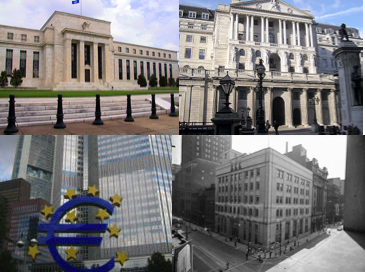Central Banks Will Send Economies Spiraling And Precious Metals Skyrocketing
Experts believe that negligent central bank actions will send precious metals prices up!

Central banks have been doing everything they can to stimulate economic growth for some time now. However, many experts contest that the central banks aren't doing anything to really help the economy. Instead, their moves are just leading to harder times in the long run. Today, we'll talk about the controversial actions being taken by central banks around the world, why these actions have such a profoundly negative affect on the stock market, and what this means for precious metals moving forward.
The Central Bank Action That's Leading To The Debate
As mentioned above, there has been major actions taken by central banks around the world that are becoming concerning to say the least. These actions surround interest. Essentially, when economic conditions prove to be concerning, one of the first things that central banks look to do is reduce interest. In doing so, they bring the value of the currencies down. However, accessibility associated with these currencies goes up. With low interest, there's lower risk in borrowing. As a result, the goal is that consumers and businesses alike borrow more, spend more, and borrow more. This creates a revolving door that ultimately stimulates the economy.
Since 2008, we have seen interest rates at central banks around the world at or near record lows, and they are staying there today. The Federal Reserve, Bank of Japan, European Central Bank, and the Bank of England have all adopted a ZIRP, or zero interest rate policy, in order to try and save their struggling economies.
The Damaging Bubble This Creates In The Market
With borrowing easier, consumers spending more, and interest rates at all time lows, we tend to see big changes in the market. The false hope offered by low interest rates fuels economic activity, and in many cases more importantly, market activity.
With the ZIRP in place, investors aren't paying as much attention to risk as they should be. Essentially, carry trade speculators are driving asset prices up on a steady basis and fixed income spreads are becoming increasingly thinner. This means that fear and short interest have largely become a thing of the past for many investors. Buying the dips at the moment is getting more and more profitable, and seemingly less risky. At the end of the day, with the zero interest rate policy, central banks are essentially saying risks in the market will remain low at the moment and that they will give ample notice and transparency when they do decide to raise rates. At the end of the day, one of the biggest risks, assets suddenly going upside down due to a sharp spike in funding costs, has been completely eliminated from the market thanks to central bank actions.
This may seem great. However, it can't last forever. What we're actually seeing is a bubble in the stock market that has been fueled by the careless actions of central banks around the world. While the bubble lightly deflated early on in the year, the market is back to breaking records, and given current economic conditions around the world, that's a dangerous thing! At some point, this bubble is going to pop, and the implications in the market will be tremendous.
What This Means For Precious Metals
We've noticed that throughout the year, the prices of precious metals have already skyrocketed. It's clear that investors are realizing the risk of an economy and market that's dictated by a zero interest rate policy. However, I don't think we've seen the end of the gains. As the bubble in the market continues to inflate and economic conditions around the world continue to struggle thanks to a revolving door of false hopes offered by central banks around the world, we're likely to see further gains in the demand for and price of precious metals.
What Do You Think?
Where do you think precious metals are headed and why? Join the discussion in the comments below!
[Image Courtesy of Wikimedia]

















